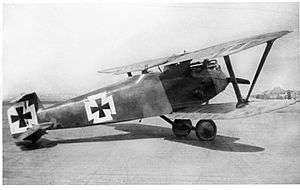Hannover C.IV
| C.IV, F.3 | |
|---|---|
 | |
| Role | Escort fighter |
| National origin | Germany |
| Manufacturer | Hannover |
|
| |
The Hannover C.IV was a prototype escort fighter built in Germany during World War I, which formed the basis for a passenger aircraft following the war. Derived from the Hannover CL.II, the C.IV shared the same basic conventional biplane configuration with the unusual biplane tail of that aircraft, but incorporated the overhanging, aerodynamically-balanced ailerons developed for the Hannover CL.III. Intended for high-altitude operations, the aircraft was equipped with a far more powerful engine than its predecessors. Another important difference was the unusual interplane strut arrangement of this aircraft. The wings were braced with two struts that converged from two attachment points on the upper wing to a single attachment point on the lower, creating a V shape when viewed from the front or rear of the aircraft. Novel at the time, this foreshadowed the Warren truss strutting arrangements that already existed on the contemporary Ansaldo SVA Italian single-engined reconnaissance aircraft designs in full form, and would be seen in the 1920s and 1930s with later Italian combat aircraft.
After the war, the C.IV was developed into the F.3, with seats for two passengers where the gunner's cockpit had been.
Specifications (C.IV)
General characteristics
- Crew: Two, pilot and gunner
- Powerplant: 1 × Maybach, 224 kW (300 hp)
References
| Wikimedia Commons has media related to Hannover C.IV. |
- Taylor, Michael J. H. (1989). Jane's Encyclopedia of Aviation. London: Studio Editions. p. 469.
- Jane's All the World's Aircraft 1919. London: Sampson Low Marston. p. 315.
